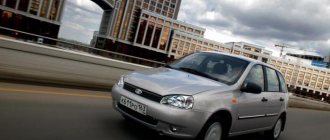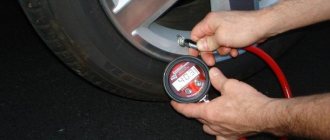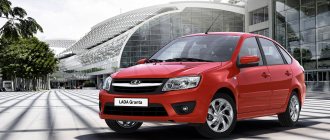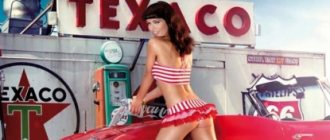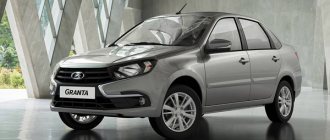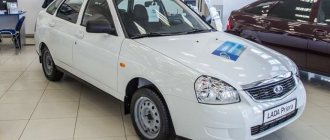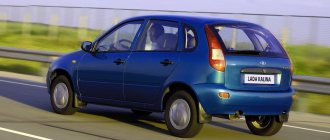Article on the topic
How has LADA Kalina changed?
Need for Race - this is what the abbreviation NFR stands for, and the translation from English sounds like “thirst for race.” This eloquent name is given to the sportiest production model of the Tolyatti Automobile Plant. It is produced at the AvtoVAZ subsidiary LADA Sport. The official premiere of the model took place during the Russian stage of the WTCC World Championship on the Moscow RaceWay track, and those especially in need were given the opportunity to test the new product.
The appearance of the charged hatchback differs from the regular Lada Kalina in a small number of details. But they are so significant that it immediately becomes clear: this car is not only for simple movement from point A to point B. The “face” has become stricter - the chrome inserts of the radiator grille and fog lamp surrounds have been removed. At the rear there is a spoiler that continues the roof line, plus a diffuser. However, these details are common to two sports Kalinas - Sport and NFR. The second car can be distinguished by 17-inch wheels with five mounting bolts instead of four, shod with low-profile tires. And, perhaps, the most striking, but not the most useful detail was the air intake grilles on the hood. They look impressive, but do not greatly affect engine cooling, but they open up access for dust and moisture into the engine compartment. And just a small touch - a carbon fiber substrate under the boat of the Lada emblem on the radiator grille.
Lada Kalina NFR. Photo: AiF / Irina Zverkova
The interior of the sports version has a special finish - leather is used wherever possible: the steering wheel, the cover on the gear lever, and the handbrake have such a finish. All seams are stitched with orange threads, this color has become a signature color for NFR. A small note - a bright line on the steering wheel marks its central position, like that of real athletes. The seats, in addition to inserts made of material similar to Alcantara, have embroidery with an abbreviation. The rear sofa has not changed (except for the upholstery), and the front seats have a more ergonomic shape with developed lateral support and an elongated seat cushion. It’s really comfortable to sit in them, the dense texture provides a connection with the car, and you won’t slip out of the seat when cornering. Otherwise, everything is the same as the regular Kalina with a multimedia system and air conditioning.
Lada Kalina NFR. Photo: AiF / Irina Zverkova
If from the point of view of the appearance of the Lada Kalina NFR the changes are superficial, then everything related to technology has been radically redone. The main thing is a sixteen-valve engine with a volume of 1595 cm³. Official sources indicate its power at 140 hp. With. at 6750 rpm, but during the presentation, plant representatives named the figure at 135. Still, this is enough for excellent dynamics, and it’s not so important, since work on the power units continues. So, for example, on the previous day, my colleague put the tachometer needle in the 7000 rpm zone, but the engine continued to run. Only common sense kept him from being able to “twist” it. During my races, a cut-off had already appeared, and at the same load the fuel supply was reduced, and the engine “fell asleep” from suffocation. Apparently, the engineers were able to reconfigure the software overnight.
Lada Kalina NFR. Photo: AiF / Irina Zverkova
Develop such power and torque of 165 Nm at 4700 rpm. allowed a whole range of changes to the engine. The main thing is that the intake receiver, camshafts, and exhaust manifold have been improved. Some of the technologies are borrowed from the Lada Granta Cup, that is, a completely combat car that participates in racing. But the gearbox remained standard: a 5-speed manual with cable drive and a 4.3 main gear. For rigidity and reliability, the heavy engine and front suspension parts are mounted on an original subframe. There were also constructive solutions that became available thanks to cooperation with the Renault-Nissan alliance. French parts, in particular from Megane, are used in the reinforced drive, suspension and braking system.
Lada Kalina NFR. Photo: AiF / Irina Zverkova
Turn the key in the ignition and the engine comes to life, hesitantly thrashing its pistons at idle. Its element is high speeds, so at low speeds you can hear some instability in operation. The NFR's clutch is almost civilian, the pedal travel is long and allows you to move off smoothly without fear of stopping the engine. The brake and accelerator pedals have the same characteristics. You get used to them very quickly and get the result from pressing that you expect.
Driving out onto a straight highway makes it possible to check the acceleration of the car. Lada Kalina NFR picks up speed very confidently and dynamically if you keep the speed in the red zone. A slight dip occurs when switching to second gear - the power units seem to freeze for a second, and then continue to accelerate the car with the same tenacity. The whole process is accompanied by the howling of the engine, which sometimes reaches the level of screeching. Plus noticeable aerodynamic noise at speeds over 130 km/h. But even despite the noise, going fast at the NFR is rather pleasant.
Lada Kalina NFR. Photo: AiF / Irina Zverkova
And all thanks to the sporty suspension settings. It is very tough - you can feel every seam and pebble on the asphalt. In addition, lower profile tires have lost some of their damping properties. A broken road or speed bumps become a challenge, besides, the ground clearance has been reduced by 20 mm compared to the regular Kalina, and the resulting 130 may not be enough in some places. But the car is stable in corners and feels like a single monolithic piece, and not like a wreck falling apart. I would like the steering wheel to be a little heavier and more informative, but then in “civilian” traffic (read: parking), maneuvering will turn into hard labor. In general, the balance is normal.
Normal for those who need an honest hardware, without electronic bells and whistles, allowing the driver to show his driving skills. The only drawback in this device called Lada Kalina NFR is the price. It has not yet been officially announced, but judging by the comments of LADA Sport managers, they will not meet the 600,000 rubles. At the same time, similar hot hatchbacks, similar in ideology, cost several times more: Renault Clio RS - from 1,131,000 rubles, Volkswagen Golf GTI - from 1,317,000 rubles. The more civilized Opel Astra GTC is offered for RUB 749,000. and more expensive, but its spirit is no longer the same, if only because of the choice of engines. Of course, for an amount of more than 600 thousand, a sufficient number of Russian-made foreign cars are offered, which will have almost the same engine power and a more comfortable interior. But they can only satisfy the need to own a car. They are not for those who have a real thirst for racing.
Lada Kalina NFR. Photo: AiF / Irina Zverkova
Lada Kalina nfr-best_new size
FOR THOSE OVER 200
Intense acceleration with engine revs up to seven thousand revolutions: finally, fifth gear, gas pedal to the floor! "Kalina" rushes along the high-speed oval of the Russian "Indianapolis". To the accompaniment of the direct-flow exhaust system, the speedometer needle confidently overcomes the o and creeps further. Well, honey, there’s only a little time left before the psychological barrier...
Eat! Two hundred! It would be possible to gain a couple more kilometers of the maximum speed, but it’s time to slow down: the profiled turns of the AvtoVAZ test site in Sosnovka are wet, flying into them at full speed is arrogance.
I'm trying to remember at least one domestic car that can accelerate to 200 km/h. Not a one-off piece, but a commercial vehicle for the average consumer. Perhaps the small-scale VAZ-21106 sedan from the mid-nineties. But under its hood there was a two-liter Opel engine, and on the Kalina NFR there was a modified naturally aspirated VAZ-21126 engine with a power of 140 hp. This is the fastest Russian hatchback. It was made in the engineering and production facility, part of OJSC AVTOVAZ. Now "Kalina NFR", or, if officially, VAZ-219259-81-020, is undergoing certification tests, and will go on sale by the end of summer.
Specifications
The engine has become the highlight of the hatchback. This is a 1.6-liter, four-cylinder in-line engine with a power of 136 hp. With. Peak power is achieved at 6750 rpm, torque – 165 Nm, fuel consumption – 7-9 liters per 100 km. The 126 engine from Priora was taken as the basis, which was boosted by modernizing the injection system and installing new firmware.
The engine is combined with a 5-speed manual gearbox with a cable drive from the Lada Kalina Sport. In tandem, they accelerate the NFR from zero to 100 km/h in 9.2 seconds. In Kalina Sport this figure is 9.5 seconds, but the engine power is 118 “horses”. The maximum speed is set at 203 km/h (sport version – 198 km/h).
In terms of its design, the Lada Kalina with the NFR prefix is not much different from the production model. At the rear there is the same lowered semi-independent rigid beam with hydraulic shock absorbers and springs. Gas-oil shock absorbers and stiffer springs are installed at the front.
The steering mechanism is supplemented with an electric booster. Braking system – all-round disc, ventilated brake discs (front – 296 mm, rear – 260 mm). The hubs are equipped with five studs for mounting 17-inch wheels with low-profile tires 205/40 R17.
Since the end of 2016, the car has been equipped with a mechanical locking center differential. The main purpose of this option is to improve handling, make steering more sensitive, and increase torque efficiency.
a1–1
I met Kalina NFR back in February, when, at the invitation of AVTOVAZ, I came to take part in a parallel race for the factory President's Cup.
Specially prepared cup cars corresponding to the National class are a song! The engine is pumped up to 150 horsepower (electronic throttle drive, new “brains” and all that), disc differential lock, reinforced suspension, retuned brakes, Black Rocket tires with 4.5 mm studs... Of course, a homologated frame, five-point belts, removable steering wheel for easier landing. But - the same devices (you can even control the degree of throttle opening), gearbox, suspension and a minimum of interior parts in order to reduce the weight of the car to 990 kg.
At the start, it is important to move off smoothly, without spinning the engine above 2200 rpm, otherwise you will grind the ice for a long time. And then - almost all the time full throttle, and the third gear becomes the main working gear.
Lada Kalina NFR R1
Lada Kalina NFR R1.
As they assure, the configuration of the safety cage was calculated taking into account the rigidity of the entire body-frame system. Lada Kalina NFR R1. As they assure, the configuration of the safety cage was calculated taking into account the rigidity of the entire body-frame system.
And who would have reminded me of this when I was looking for a common language with the car at the race track! Bearing in mind that the cut-off on the standard engine of the editorial Kalina operates at 6200, I switched on the “energy” at these speeds - especially since the shift-light (indicator on the instrument panel) told me the same thing. It turns out that this is early - the unit even develops maximum power at 6800 rpm! And if you don’t squeeze all the juices out of it, then you won’t feel any special dynamics: starting from idle, Kalina picks up speed quickly and smoothly, but without a spark - until the tachometer needle reaches the five thousandth mark, when the engine produces a maximum of 154 Nm. You expect more from a 136-horsepower sports car, but Euro-5 toxicity standards noticeably dampen the spirit.
The only change in the gearbox is a different main pair: standard gears with a 3.7 ratio are replaced by alternative ones with a 4.3 ratio. In everyday driving, this results in increased noise produced by the engine operating at high speeds, and on the racetrack it helps to accelerate more intensely when exiting a turn. Sometimes there is even too much traction: the inner wheel towards the turn begins to slip. The problem will be solved by installing a limited slip differential, and Nezvankin’s working Kalina has one. If you wish, you can buy a lock, since such a unit for domestic models (produced by Togliatti) will cost only 10 thousand rubles.
Small-scale production generally affects the individuality of “eneferok”. “Very precise, sensitive and understandable steering is completely indifferent to wheel jumps over potholes and intensive work of the chassis. There’s complete calm on the rim!” — Vadim Kryuchkov noted a year ago, having become acquainted with one of the first cars. And she received such praise on the rough roads in the vicinity of Tolyatti! And now, at the race track, I let go at the exit of the turn, the loaded wheels hit the neat curb, and the steering wheel is shaken by impacts. Apparently, then Vadim got a car with power steering from the Korean company Mando, which works much better than the amplifier supplied by Kaluga Autoelectronics.
a1–2
This one went too fast in a fast turn.
God has had mercy on me. This one went too fast in a fast turn. God has had mercy on me.
On the only uphill straight you manage to switch to fourth gear, and this is already over 130 km/h. The rest of the route you walk sideways, and two-thirds of the turns are blind, because they are hidden by tall parapets. The main thing is to remember the route and overcome fear, because the car listens to you like a god.
At the beginning of the turn, you slightly point the Kalina with its muzzle into the parapet - and full throttle! You lick the turn sideways, slightly cutting off the crust with the bumper, the diff lock itself pulls you to the ideal radius - and now you are already at the exit, slightly correcting the slight drift. You approach the next bend, with a light reset you shift the car to the other side - and start all over again.
The steering feel is amazing. And how are the electronic gas pedal and brake drive configured? The number of times I pressed is the same amount I received. This is the first Lada in my life, from which I was delighted as a puppy.
Comparison with closest competitors
The cost of the car is quite high. In the segment of Russian cars in its class, this is the most expensive model. The closest competitors are Granta Sport and Kalina Sport. Among foreign cars the situation is different; the following models are available for the same money:
- Skoda Fabia RS – 1.4 liter engine, 180 hp. s., turbocharging, acceleration to hundreds in 7.3 seconds, top speed – 224 km/h.
- Volkswagen Polo GT – 125 “horses”, engine capacity – 1.4 liters.
- Skoda Rapid with a 1.4 liter turbocharged engine and a 7-speed DSG gearbox.
- KIA pro_cee'd with a 1.6 liter engine and a power of 135 hp. With.
You can also consider a used Renault Clio RS with a 1.6 liter turbocharged engine producing 200 hp. s., allowing you to reach a maximum speed of 235 km/h.
a1–3
What could be more spectacular than a winter race with a parallel start?
What could be more spectacular than a winter race with a parallel start?
I didn’t win anything in the race—I didn’t even make it to the final heats. The winter track at the AvtoVAZ testing ground in Sosnovka is treacherous: one mistake and you’ll end up on the roof or, even worse, stuck in a tunnel at the intersection of the tracks. I tried my best. I lost a little more than a second to the director of the Izhevsk Automobile Plant, Mikhail Ryabov, who had a serious fighting record behind him and who eventually took the main prize. But the time I showed on my starting track remained among the best for a long time - until the track was thoroughly rolled out. In general, there is no shame.
And I only benefited from communicating with Kalina NFR. I hope this is not our last meeting.
SPORTS CONVEYOR
Lada Sport LLC is a subsidiary of AVTOVAZ. His specialization is the development and production of sports models. Precisely sports ones, that is, hot versions based on serial ones. What is the production level? What is this - a workshop, a garage, a hangar? In short, it is a recently built full-fledged plant with a conveyor and workshops where components, assemblies and systems are assembled. This year's production plan is 4,150 cars. Of these: 2800 - Granta Sport, 1200 - Kalina Sport, 150 - Kalina NFR.
Dry numbers, alas, do not reflect the whole essence. “Lada Sport” is the first purely sports conveyor in the history of the domestic automobile industry! How it works will become clear from the photo report. On the day of filming, “Grants” crawled along the thread. Let's follow their path.
Photo gallery
Lada Kalina NFR: thirst quencher
Options and prices
All cars from Lada Sport are produced in the maximum configuration by default. It includes:
- front airbags;
- ABS system;
- multimedia system;
- heated front seats;
- rain and light sensors;
- fog lights;
- air conditioner;
- parking sensors
The division plans to release an exclusive version of the NFR, equipped with a turbocharged engine capable of increasing power to 180 hp. With. In 2015, the estimated cost was 650,000 rubles for the Light version, which had 16-inch wheels and brakes from the Kalina Sport version, and also lacked some additional options for the maximum configuration. But the real price turned out to be 820,000 rubles, and later even 850,000 rubles, while Kalina Sport is estimated at 550,000 rubles.
At the same time, the latter is practically in no way inferior to the NFR in terms of equipment and technical capabilities. Sales did not live up to expectations; there were few people willing to shell out an additional 300,000 rubles for yellow stitching, a new instrument panel and an NFR nameplate. For this reason, after the production of the first 50 Lada Kalina NFR cars, they are produced only by order.
Lada Kalina NFR
Lada Kalina NFR.
Lap time 2:07.0 Lada Kalina NFR. Lap time 2:07.0
In particular, thanks to this, the combat Kalina NFR R1 turned out to be much faster. Tenacious semi-slick Yokohama A048 tires and a weight of 1170 kg, coupled with a more powerful engine, closer gear rows and a limited slip differential, allowed the pilot to complete the qualifying lap in 1 minute 54.5 seconds.
Other Kalinas of the SMP RSKG National Championship, not weighted down with ballast for success in previous races, are another one and a half seconds faster here.
So, if you set such a task, the civilian Kalina NFR can be quite prepared for amateur competitions - its chassis is configured as it should. Fans of track days are not ready to pay 850 thousand rubles in order to then disassemble half the interior, get rid of excess brakes and wheels - it’s easier to build the right car from a standard Kalina. It is not surprising that Kalina NFR never found its audience. An NFR Light version with the same 136-horsepower engine, subframe, but without hypertrophied brakes and with a budget interior would help unblock the sluggish demand - and I hope that it will bring such a modification to its assembly line.
Lada Kalina NFR vs racing Kalina NFR R1: anti-lock
Lada Kalina NFR R1
Lada Kalina NFR R1.
Lap time 1:54.5 Lada Kalina NFR R1. Lap time 1:54.5
But if you stay within the confines of asphalt, then, in general, there is nothing to complain about. The Kalina NFR really handles accurately, behaves neutrally when cornering, and only the seats are not able to reliably fix the body under high lateral g-forces, which is why the steering wheel and interior elements, which you have to rest against with your knees, begin to serve as the fulcrum. The seats here are original, with a good profile, grippy upholstery and relatively well-developed support, but fans of track days will still have to change them to sports ones; in addition, the seating position will become lower, closer to the desired one.
The racing Kalina NFR R1 does not have the task of being comfortable in everyday use, so everything here is tailored for driving on racetracks. You can fit into the composite “bucket” of Sparco Circuit only by removing the OMP steering wheel, but then you don’t want to leave your workplace. Before your eyes is not the colorful display that the road version flaunts, but the monochrome monitor of the AiM MXL Pro05 telemetry system. The price of such a thing is about two hundred thousand rubles, but in racing it significantly simplifies life: you can get comprehensive information about the condition of the car and the athlete’s driving style. On the center console there is an ignition switch, next to it there is a starter button... Let's go?
More is not better
As expected, the ring Kalina NFR R1 is much more assembled and more accurate than the civilian Kalina NFR. Better acceleration dynamics, more accurate responses to steering wheel turns, and even brakes without ABS are good here. Firstly, you expect this, and secondly, the contours here are not diagonal, but spread along the axes - and the regulator allows you to select the pressure in the rear line. And the mechanisms, despite the fact that the front wheels have smaller diameters than in the road Kalina NFR, work no less efficiently.
